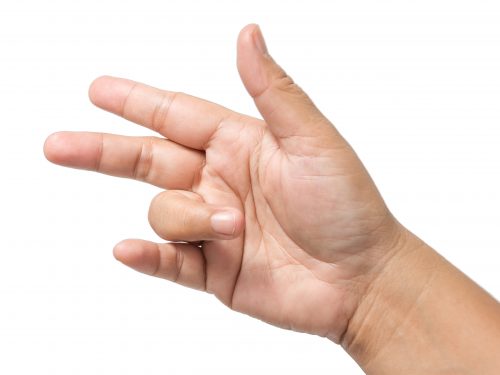Trigger finger or thumb
Trigger finger or thumb is a condition that causes pain, stiffness, and a sensation of locking or catching when you bend and straighten your finger. The condition is also known as “stenosing tenosynovitis.” Trigger finger or thumb is caused by a thickening around the tendon which bends your finger or thumb. The ring finger and thumb are most often affected by trigger finger, but it can occur in the other fingers, as well. It is more common in women than men and may be linked to diabetes.
Treatment is needed if the triggering of your finger or thumb is causing discomfort or stopping you from being able to perform normal daily activities.

TRIGGER FINGER OR THUMB SURGERY – FACTS
| Length of surgery | 30 minutes |
| Anaesthesia | Local anaesthetic |
| Hospital stay | Day case |
| Risks/complications of surgery | Frequent: Swelling, stiffness, discomfort on movement Infrequent: Infection, bleeding (haematoma), delayed wound healing, painful scar, damage to the nerve, recurrence, incomplete resolution of symptoms, complex regional pain syndrome |
| Recovery | 1-2 weeks until return to office work |
| Driving | 1 weeks |
| Hand position | Elevation above the heart level |
| Follow up | 1 week, 6 weeks, 3 months, 6 months |
| Duration of results | Permanent |
DOWNLOAD FURTHER INFORMATION
Trigger Finger or Thumb
Any hand surgery procedure is a personal choice and understandably there are a number of questions that arise. This information sheet is a general guide for patients considering trigger finger or thumb treatment under the care of Dr Mackenzie. It should provide the answers to some questions that you may have.
What is trigger finger/thumb?
Trigger finger is a condition in which the sheath for the flexor tendon of a finger or the thumb thickens and narrows. This causes the flexor tendon to lock or catch when the finger bends and straightens, leading to pain, intermittent snapping (“triggering”) or actual locking of the affected finger/thumb.
Each of the flexor tendons passes through a tunnel in the palm and fingers that allows it to glide smoothly as the finger bends and straightens. This tunnel is called the “tendon sheath.” Along the tendon sheath, bands of tissue called “pulleys” hold the flexor tendons closely to the finger bones. The tendons pass through the pulleys as the finger moves. The pulley at the base of the finger is called the “A1 pulley.” This is the pulley that is most often involved in trigger finger.
In a patient with trigger finger, the A1 pulley becomes inflamed or thickened, making it harder for the flexor tendon to glide through it as the finger bends. Over time, the flexor tendon may also become inflamed and develop a small nodule on its surface. When the finger flexes and the nodule passes through the pulley, there is a sensation of catching or popping. This is often painful.
What are the symptoms of trigger finger?
Symptoms of trigger finger often start without a single injury. They may follow a period of heavy or extensive hand use, particularly pinching and grasping activities.
They may include:
- Swelling, stiffness and pain with the grasp
- Tender lump at the base of the finger/thumb on the palm side of the hand
- Catching or locking sensation with finger movement
- Pain on bending or straightening of the finger
- In severe cases, involved finger may become locked in a bent position